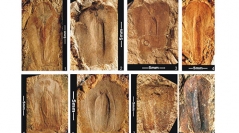

 Comptes Rendus Palevol
9 (8) - Pages 479-486
Comptes Rendus Palevol
9 (8) - Pages 479-486Fossil plants are scarce in the Earliest Triassic marine deposits of western Guizhou and eastern Yunnan. Only Annularia shirakii, Lobatannularia sp., Paracalamites stenocostatus, Gigantopteris sp., Pecopteris sp. were reported from the base of the Kayitou Formation dated as Early Induan by marine fauna. Recently, we discovered numerous representatives of the genus Annalepis in the same Lowermost Triassic beds: A. latiloba, A. brevicystis, A. angusta, Annalepis spp. occur associated with a basal Triassic marine fauna. This discovery fills the biostratigraphic gap between the Late Permian “Gigantonoclea guizhouensis - Ullmannia cf. bronnii - Annularia pingloensis” and the late Lower Triassic “Neuropteridium–Albertia–Voltzia” assemblages reported from South China. It represents an important datum dealing with the very beginning of a new terrestrial flora installation after the Permian flora disappearance following the Permian–Triassic boundary mass extinction. This “starting point” of a new vegetal cover in South China is to be taken into account in reconstructing through space and time the settlement process of the Mesozoic floristic provinces.
Annalepis, Pioneering plant, Permian–Lower Triassic, Floral recovery, South China